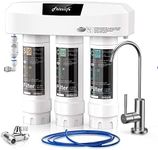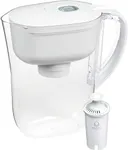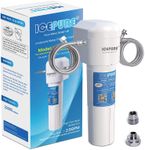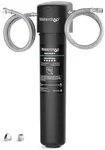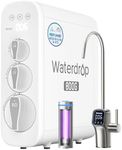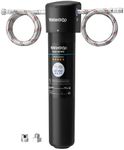Buying Guide for the Best Water Filter Systems
Choosing the right water filter system is important for ensuring that the water you and your family drink is clean, safe, and tastes good. There are many types of water filters, each designed to remove different contaminants and suit different household needs. Before making a decision, think about the quality of your tap water, the contaminants you want to remove, the amount of water you use daily, and how much maintenance you are willing to do. Understanding the key specifications will help you find a system that fits your lifestyle and provides the level of filtration you need.Filtration MethodThe filtration method refers to the technology the system uses to clean your water, such as activated carbon, reverse osmosis, UV purification, or ceramic filters. This is important because different methods target different contaminants. For example, activated carbon is good for removing chlorine and improving taste, while reverse osmosis can remove a wider range of impurities, including heavy metals and some bacteria. UV systems are effective against microorganisms. When choosing, consider what is in your water (you can check with a water quality report or test kit) and match the filtration method to those needs. If you only want to improve taste and odor, a simple carbon filter may be enough, but for more comprehensive purification, look for systems with multiple stages or advanced methods.
Contaminant RemovalThis specification tells you which and how many contaminants the filter can remove, such as lead, chlorine, bacteria, pesticides, or sediment. It's important because not all filters remove all contaminants. Some are designed for basic taste and odor improvement, while others target specific health risks. Systems are often certified to remove certain substances, so check for certifications or performance data. To pick the right one, identify the main concerns in your water supply—whether it's heavy metals, chemicals, or microbes—and choose a filter that is proven to address those issues.
Filter Capacity and LifespanFilter capacity refers to how much water the filter can process before it needs to be replaced, usually measured in gallons or liters. Lifespan is often given in months. This matters because it affects how often you'll need to change the filter and the ongoing maintenance involved. Smaller, pitcher-style filters may need changing every couple of months, while larger under-sink or whole-house systems can last much longer. If you have a large household or use a lot of water, look for a system with a higher capacity to reduce the frequency of replacements. For smaller households or occasional use, a lower capacity may be sufficient.
Flow RateFlow rate is the amount of filtered water the system can deliver per minute, usually measured in gallons per minute (GPM) or liters per minute (LPM). This is important because it affects how quickly you can get filtered water, especially if you need to fill large containers or use the filter for multiple purposes. Lower flow rates are common in more thorough filtration systems, like reverse osmosis, while higher flow rates are found in simpler systems. If you need filtered water quickly or for multiple taps, look for a higher flow rate. For single-use or drinking water only, a lower flow rate may be acceptable.
Installation TypeInstallation type refers to how and where the filter system is set up, such as countertop, under-sink, faucet-mounted, or whole-house. This is important because it affects convenience, space requirements, and the amount of water filtered. Countertop and pitcher filters are easy to install and move, but only filter small amounts. Under-sink and whole-house systems require more installation effort but provide filtered water to more outlets. Choose the installation type based on your living situation, available space, and whether you want filtered water at just one tap or throughout your home.
Maintenance RequirementsMaintenance requirements include how often you need to replace filters, clean the system, or perform other upkeep. This is important because regular maintenance ensures the filter works effectively and keeps your water safe. Some systems have easy-to-change filters and clear indicators, while others require more effort. If you prefer low-maintenance options, look for systems with longer-lasting filters and simple replacement processes. If you don't mind more frequent attention, you can consider systems with shorter filter lifespans.


